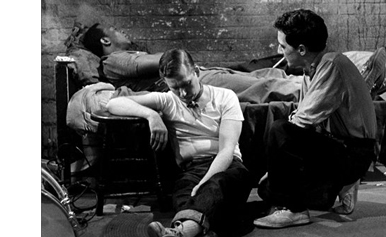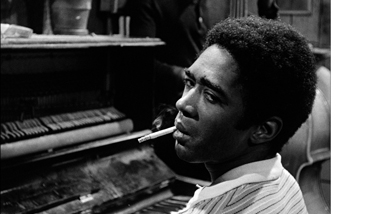
 |
|
|
|
I think one of the first 'important' independent films I heard championed around UCLA in 1970 was Shirley Clarke's The Connection. I'm sure that few of the faculty had actually seen it, yet it was written up in all the new film books extolling the various new independent and underground film rebellions against commercial Hollywood-style filmmaking that had peaked in the 1960s. With certain exceptions UCLA tended to be ten years behind the times, yet still progressive. We had student-artists in residences like Charles Burnett, and also a couple of graduate students that sidestepped the rules to make commercial feature films, sometimes monopolizing the available film equipment. But ... good for them. Shirley Clarke was a major proponent of the New American Cinema Group, a loose New York consortium of filmmakers that championed the work of Lionel Rogosin, John Cassavetes, Alfred Leslie, Robert Frank and Bert Stern. A maker of short subjects, the socially connected and financially independent Clarke enjoyed a brief run of stellar work. First up was The Connection, an anomaly for independent work shot in that it was filmed in 35mm by a union crew, on a constructed set like any other mainstream fiction film. Jack Geiber adapted his off-Broadway play, a long one-act about a group of junkies waiting for their fix. As an added inducement, the play served as a jazz concert as well -- several of the anxious men are musicians. Three performances were spaced out, perhaps dividing the show into acts. Clarke's only substantive alteration to the play was to change a journalist character into a filmmaker, adding a level of filmic distance. What we see is in a way 'found footage'; as was Shirley Clarke's style, camera roll-outs, stage waits and director's instructions are part of the movie. 
The Connection made Clarke an immediate star director at Cannes, but the New York censors effectively killed off any hope of it receiving a theatrical release. It opened and closed in one day in Manhattan -- the projectionist was arrested! -- and a subsequent attempt to show it in a church that sponsored an addiction clinic was also stopped by the authorities. The big contention was over the use of the word 'shit', a common word for heroin. That, and a couple of close-ups of the porno mags read by the denizens of Geiber's play stopped the show cold. But the unspoken message from above was surely that the freedom of speech didn't apply to motion picture screens. Drug addiction was bad. Junkies are bad. The whole subject was unofficially Taboo. As part of its ongoing Project Shirley, The Milestone Cinematheque has been giving the late Ms. Clarke's films the royal treatment. Mastered from the original negative, The Connection on HD probably looks better than the first answer print out of the lab, as good as any B&W film I've seen transferred to home video. An opening title tells us that cameraman J.J. Burden (Roscoe Lee Brown) has finished a film begun by Jim Dunn (William Redfield), a documentarian seeking to tell the truth about junkies. About a dozen heroin addicts hang out in the loft of Leach (Warren Finnerty), a malcontent with an unexplained abscess or wound, on his neck. Leach's 'tenants' include a number of dopers likewise waiting for their connection, the suave Cowboy (Carl Lee). The cowardly, dishonest Ernie (Garry Goodrow) becomes more nervous as time goes by. Cheerful Solly (Jerome Raphael) is the only one with an appetite; he passes the time looking at a gay-oriented male art magazine. Freddy (Freddie Redd) plays the piano, forming a combo with Jackie (Jackie McLean) and Larry (Larry Richie). Sam (Jim Anderson) rests on a cot. Filmmaker Jim has apparently paid the men to cooperate but is upset that nothing 'exciting' is happening. The junkies take turns directly addressing the camera. When Cowboy finally arrives he brings with him an elderly, slightly addled street preacher in a Salvation Army uniform, Sister Salvation (Barbara Winchester). She understands nothing and assumes that the junkies are taking turns with Cowboy in the bathroom, to drink wine. Everybody reacts differently to the fix. Leach is upset that he's not feeling anything. Cowboy tells him that his resistance is too high, but Leach insists that he's been cheated and wants to shoot up again. Meanwhile, the boys have successfully talked filmmaker Jim into shooting up as well. How will he react? 
The Connection is certainly theatrical, but its stylized version of reality eventually wins out. For a while it resembles 'Waiting for Godot', with everybody asking when Cowboy is going to arrive. The show proves that it knows of what it speaks when the junkies get their fixes. Some are just happy, others zone out, while Leach becomes irritable that he's feeling no effect. To the play's credit, the various direct-to-camera soliloquies are illuminating, not 'bad one-act' material or dominated by faux hip-speak. The dialogue doesn't pretend that we're getting deep into personalities. Most complain, others discuss the nature of their addiction: 'I believe heroin was made illegal so someone could make money'. Cowboy becomes angry when he talks about having to live on the move, always hunted by the cops.

The cast includes some prominent names. William Redfield had a long list of credits, as does Garry Goodrow. Roscoe Lee Brown and Carl Lee enjoyed busy careers after this. The experienced Warren Finnerty surprises us. In general appearance and behavior he resembles Steve Buscemi, and he walks around angry, gripping his wounded neck. We wonder if the Coen brothers purposely modeled Buscemi's character Carl Showalter in Fargo after this movie. The ensemble blends quite well. The effect is of course like a waiting room in a modern hell, with Sister Salvation's visit included for mild comedy relief. A man with a phonograph enters and plays part of a jazz record, a ritual that comes off as a bit of avant-garde absurdity.
The Milestone Cinematheque's Blu-ray of The Connection is a dazzling scan of this rare feature. One doesn't expect to see a vintage experimental film looking this pristine. There are no flaws or dings of any sort; we're told that UCLA restorer Ross Lipman had to substitute a reel due to scratches, but I saw no drop in quality. The film looks fine transferred at 1:33, and the opening title card makes that ratio seem correct. Almost all of the show could have been cropped to at least 1:66 and only lost parts of ceilings and floors, yet we must assume that Milestone and Lipman researched their decision thoroughly. 
Several of the excellent extras are set to jazz cues from the film. I'd first direct readers to Milestone's informative Press PDF on the film and Shirley Clarke. The disc itself begins with a six-minute 16mm reel of on-set home movies. Art Director Albert Brenner sits for an interview (the volume is rather low), explaining how production designer Richard Sylbert delegated most of the work to him. Actor-musician Freddie Redd tells all in a half-hour featurette, describing his career and work on The Connection. He remembers Shirley Clarke as an exacting, demanding director. A gallery of sharp BTS stills, a new trailer, and a short home movie of Carl Lee on a rooftop are included as well. As an audio extra we hear a couple of songs stylized in the same mood as Freddie Redd's Connection score, "Who Killed Cock Robin?" and "I'm In Love." I also have waiting to be reviewed Shirley Clarke's In the Land of the Headhunters, another Milestone Cinematheque restoration.
On a scale of Excellent, Good, Fair, and Poor,
The Connection Blu-ray

The version of this review on the Savant main site has additional images, footnotes and credits information, and may be updated and annotated with reader input and graphics.
Review Staff | About DVD Talk | Newsletter Subscribe | Join DVD Talk Forum |
| ||||||||||||||||||